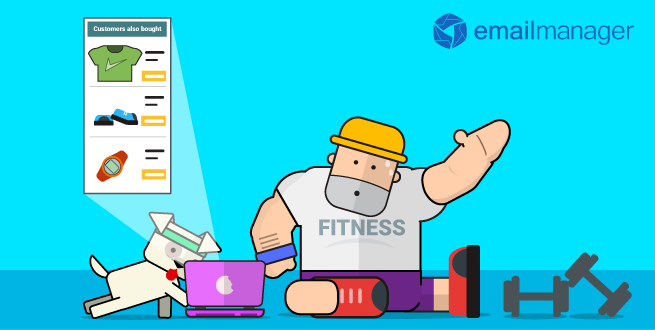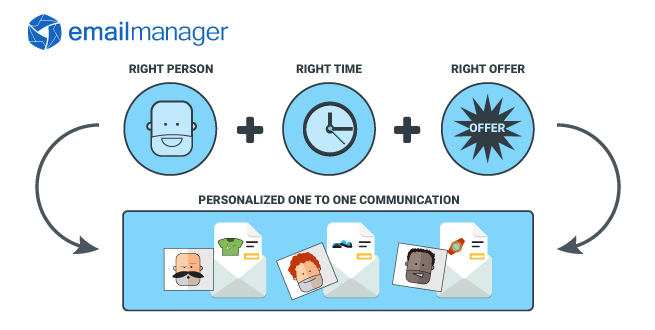How dynamic content can power up your email marketing
Published in 11 de julio de 2016
Real-time dynamic content. If you ever bought a book on Amazon you will probably know what we are talking about. The website that first introduced the magic of personalized recommendations dropped jaws everywhere. The concept evolved and now we can use dynamic content (DC), or some may say, smart content in many marketing tools.
Dynamic content creates a personalized and customized experience for the customer, building a content relevancy and increasing your chances of conversion. Personalizing your emails is one of the most important practices when considering your whole email marketing strategy. But the majority of marketing professionals don't know where to start.
So let's start from the beginning:
- How does dynamic content works
- The key benefits of dynamic content
- Step by step on dynamic content
- The different types of dynamic content
- Common mistakes
- DC: the sky is the limit
How does dynamic content works
It may sound like your customers are getting spoiled but the truth is that the amount of competition out there is fierce, and the more you give your customer what they are looking for, more chances you have to earn your place
A successful marketing strategy gives the customer what they want, at the time they want it and, sometimes, it can even anticipate their wishes. Here is where dynamic content steps in.
Dynamic content provides easy access to relevant information and increases the effectiveness of your campaigns. But what does it means?
Easy access means that your customers will receive the information they're looking for, on a regular basis, in their inboxes. It also means that
The content that they will receive is relevant for their current situation. It will help them solve a problem, satisfy a wish or even help them through a decision-making situation.
With that said, your campaigns need to be more effective. If you cut straight to the
Relevant emails drive 18X more revenue than broadcast emails
The concept of dynamic content on email marketing is rather simple: your email content has specific areas that display different texts or images, according to the customer segmentation you chose. It can be displayed in the form of articles, images, product offers or calls to action; based on the customer's gender, preferences, demographic data, purchase history, etc.
Dynamic content will help you reduce the time you spent on creating numerous campaigns to different contact lists. It will improve your click-through rates, increase your ROI and, also, minimize your opt-outs - as your customers learn that your emails are, probably, always relevant to them.
The key benefits of dynamic content
In email marketing, it's not unusual to face low engagement rates and shrinking contacts lists. A marketing professional need to know that subscribers are unique, have different needs and reactions. Although most of
There are a few key benefits of dynamic content that will help you on a long-term basis to achieve one of the marketing biggest goals: retain customers. First of all, DC generates email engagement, which then leads to email conversions and, ultimately, creates loyal customers.
There a few great examples of dynamic content on
They were promoting a travel expo: to create the customer's desire on
Another good example is the app Disney Movies Anywhere, that allows the customers to watch Disney Movies - as the name says itself - everywhere. The app uses a reward program to encourage the customers to remain loyal to the app.
The emails sent by the company displays real-time point balances to the users and make offers based on available inventory. In fact, this can be a great strategy for companies that have loyalty programs: displaying real-time
Step by step on dynamic content
When you decide on working with dynamic content, there are a few steps to follow to make the most of your strategy. Remember that planning is the key to
- Decide what content will be dynamic: come up with a hypothesis. For example, if
your believe that showing content according to gender will increase your click-through rates, bet on that to make the most of your strategy. - Segment your list: in case you haven't done so, it's time to segment your list according to the categories that you are going to address: gender, behavior, shopping history, preferences, geolocation, age, etc. Remember to add an update info section in your emails so your customers can continue to receive relevant content from you. After all, life changes and they might not remain
at the same place or still have a dog, for example. - Create the content: once you know what changes to do and how to do it, it's time to create your content. For example, if you are creating content for different genders remember to focus on items that
highlights the male/female differences. You can use different templates, with different colors, for example, as well as customize the content itself. - Don't forget the CTA: We know that the CTA is there you ask your customer to do some sort of action. So it's only obvious that your call-to-action is also tailored according to your dynamic content.
Dynamic content will make your customer feel valuable and special. Eventually, it will improve engagement. According to Aberdeen Group, personalized emails increase click-through rates by 14% and conversion rates by 10%. So don't miss out this opportunity to make you emails more interesting.
If you want to go further and actually think outside the box, you have to use external dynamic content to make your emails more attractive. Do not limit yourself to use only your company information.
You can use weather forecast, for example, if you are trying to sell anything that has to do with weather (like trips and beach products). Any sort of data could be relevant for your audience so do your research and make your offer more tempting.

The different types of dynamic content
There are many ways to segment your audience, make tailored campaigns and achieve better results. Here are a few of them:
- Demographics: gender, age, income,
education and ethnicity. - Firmographics: company field, location, services/products and
number of employees. - Behavior: links clicked, products searched, products purchased and conversion rate.
- Psychographics: lifestyle,
interests and attitudes.
Once you have segmented your customers, you can consider a few places to use dynamic content:
- Interests. If your customer has shown interest in a particular product or type of content (checklists, ebooks, webinars), customize your email marketing to fit their interests. If your customer is a denim lover, for example, make sure that all your denim news are sent to them on a regular basis.
- Location. Think language, dialects, seasonal needs. Let's imagine you have customers all around the world. They speak different languages, are facing different weather conditions and have very different needs. You can personalize your email marketing to fit your customer's location and build a sense of familiarity. This will increase the email relevance and help you engaging and retaining customers.
- Persona. Who is your customer? A full-time mom? A high-level executive? A student? Do they know your product/service? What kind of problem are they trying to solve with it? You have to think different approaches to your products, services or content. Every persona will use what you're selling differently.
- Lifecycle. In which stage of the buying cycle is your customer? How many emails have you sent? One, ten, twenty? Consider this when writing your email. This has a huge impact on the offers you're sending, for example. The way you speak to your customer has to be different on each email. Is he already familiar with your emails? Certain types of engagement are only achieved once your customer is already accustomed to your emails.
Dynamic content will enhance the quality of your customer's experience, at low cost. It will work as a lead nurturing strategy for you. Providing relevant and adaptable content will make your company more trustable When the conversion process starts, it will be really helpful.
56% of people unsubscribed from emails due to content that’s no longer relevant
Common mistakes
Strategic errors may jeopardize the success of your campaigns. So take a look at our short tips to avoid pitfalls:
- Wrong data: this is probably the worst mistake that you can make. The whole dynamic content concept is based on data so make sure that your source is trustworthy.Remember to add an update option link in your email, in case your customer needs to change their information.
- Acquiring information that is not permission-based: although geolocation can be acquired using an anonymous IP, all other customer's information should be obtained by opt-in and conversion forms. According to a Harris Interactive/Janrain survey, 60% of people would be happy to give their personal information if the data they provided was used responsibly for their own benefit.
- Over personalization: over personalizing can be rather ineffective. Don't personalize everything on the first email you send to a customer, you might scare him. They might like relevance but no one likes to feel stalked and
catalogued . So besutil . Be casual, but formal: you are not your customer's best friend. You can gradually use your customer's data as you build your relationship.
DC: the sky is the limit
There is really no limits when thinking about dynamic content. Let's think about the following example: you're hosting a seminar and people from different places and backgrounds attend to your event. To keep track of those attendees, you can make them fill a form with their names, emails address and have their photos taken to be placed on a badge at the arrival.
In any sort of event, especially the ones focused on knowledge like seminars and conferences, feedbacks are extremely important, so why not send a personalized email to your attendees to find out their impressions,
Think about it, you already have their names, email
It might sound a little time-consuming but going that extra mile can drive more results and increase revenue. Planning your content is mandatory when working with dynamic content so take your time to create innovative material. Remember that, even though the content is different, your emails should be consistent with your overall brand strategy.